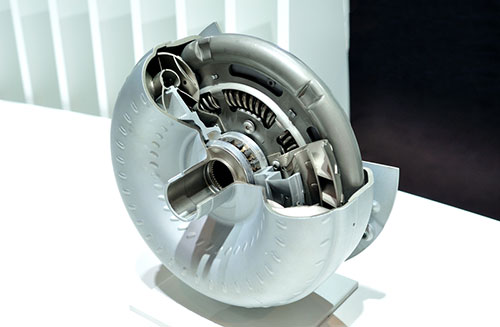The torque converter is a hydraulic device used in automobiles with automatic transmissions to decouple the engine from the gearbox and in marine propulsion systems to combine the power of two or more engines on the same axis.
Some automotive enthusiasts asked this question many times: Do manual transmissions use torque converters? Continue reading to answer this question.
In vehicles, the torque converter’s main function is to allow the engine to remain in motion when the vehicle comes to a stop. The torque transferred by the converter is maximum at medium-high revs, while it decreases considerably at low revs.
When the engine is idling and the vehicle is about to stop, the device hardly transfers any more torque and practically separates the parts so that the engine does not stop.
In a manual transmission vehicle, the same task is performed by the clutch but with the driver’s intervention. The torque converter, on the other hand, is fully automatic.
Manual transmissions systems do not use torque converters. Instead, they use a clutch, and the driver must shift the gear to achieve a smooth ride. In an automatic transmission, there exists a coupling fluid that makes automatic shifting depending on the fluid parameters.
Contents
Regimes and operation of torque converters
There are three operating modes of the automatic transmission with a torque converter: stall, acceleration, and cruising speed. Let’s find out what happens in each of them.
Stall regime
If you stop the car with the engine still running, the car will receive a torque transmission, and, by pressing the brake, the car will stop.
Acceleration
The car’s pump turns faster than the turbine at this speed, and the gearbox receives more torque. The engine energizes the motion of the oil by transmitting more torque.
Cruise speed
This speed is characterized by a practically equal speed between pump and turbine, with little power transmitted.

How do torque converters work?
The torque converter consists of a toroidal chamber consisting of three elements:
A centrifugal pump.
Also known as an impulsor, is connected to the motor shaft, which gives the flow of oil contained in it the thrust necessary for movement.
A turbine, integral with the driven part
This collects the oil flow and receives the thrust that it transmits to the gearbox
The reactor, integral with the gearbox
Serves to change the direction of the flow of oil coming from the turbine before it returns to the impeller. This third element allows the converter to have, at the start, an output torque to the turbine higher than the input torque to the impeller.
The pump is essentially a wheel equipped with radially arranged vanes that push the fluid outward due to the centrifugal force by rotating.
The liquid also acquires angular momentum. The turbine similarly consists of a paddle wheel. The liquid moved towards the outside of the device by the pump is forced to re-enter the center through the turbine blades, dragging it into rotation.
Once returned to the center, the fluid is again expelled from the turbine, completing the cycle. Even with the turbine section stationary, the spiral motion of the fluid produces an output torque.
The output torque can also be higher than the input torque, hence the name of the device: a low torque at high angular speed is converted into a high torque at low speed.
When the input shaft rotates at low speed, the device becomes inefficient (it is said to have stalled ), and only part of the input torque is present at the output.
This behavior allows you to replace the clutch with the torque converter, but with an important difference. When the engine is off, no torque is transferred from the wheels to the engine.
For this reason, vehicles with automatic transmission have a special parking function that mechanically blocks the transmission.
By its very nature, the torque converter has a slip, which causes a loss of energy in the form of heat dispersed by the fluid. Modern converters integrate a clutch system that mechanically joins the pump and turbine when the onboard computer detects a uniform cruising speed to increase energy efficiency.
Were there cars that had a manual transmission with a torque converter?
No, there were no cars that used manual transmission with a torque converter. The automatic transmission with torque converter was not as perfect as we know it.
In about seventy years, the improvements and refinements have been remarkable, so much so that it has been placed in pole position among the most used automatic transmissions.
One of the improvements that time and experience in mechanics have given to this automatic gearbox was the insertion of a clutch that connects the two rotors through a lock-up action to prevent the car from slipping.
The second modern-day improvement is the parking function, missing in the first cars with torque converter automatic transmissions. This function blocks the transmission in case of prolonged stops allowing the car to remain stationary.
Can you put a torque converter on a manual transmission?
You cannot use a torque converter on a manual transmission. This is so because manual transmission utilizes the clutch whereby the driver should shift the gear to acquire a smooth ride.
On contrary to that, the automatic transmission uses a fluid coupling concept to ensure that the gear automatically shifts depending on the fluid parameters.
Conclusion
the automatic transmission with torque converter is undoubtedly the most common type of automatic transmission. Born in the 1950s in the USA, the torque converter is applied to transmission systems to replace the classic clutch found in manual gearboxes.
The first advantage that can be identified when it comes to an automatic transmission with a torque converter is the reduction of component wear.
